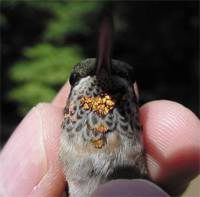Trumpet Creeper:
The Hummingbird Magnet
"Buy the amazing Hummingbird Vine, only $9.99."
That's the gist of a somewhat poetic ad that occasionally runs in tabloid magazine inserts that come with the Sunday paper. The quoted price seems a little steep for Trumpet Creeper--a plant that can be found along nearly any country roadside in the eastern U.S.--but the description is accurate: It is a vine, and it is absolutely an amazing attractant for hummingbirds. Here at Hilton Pond Center we maintain a monstrous monoculture of Trumpet Creeper that serves as centerpiece for our hummingbird trapping area, but many folks shy away from this magnificent native plant because it grows so rapidly and, coincidentally, because it causes dermatitis in cattle (and some people)--hence the alternate name of "Cow Itch."
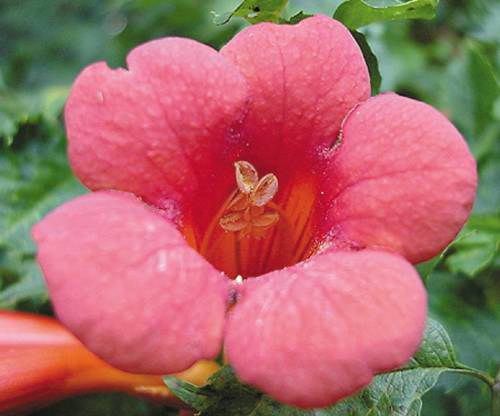
All photos & text © Hilton Pond Center
Indeed, Trumpet Creeper (Campsis radicans) is a much-maligned, under- appreciated, semi-woody vine that gardeners often avoid. It is rambunctious and can take over a corner of the yard in the course of a summer, but a little judicious pruning--sometimes reinforced with light touches of napalm--will always keep it in check. 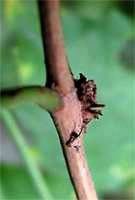 (Perhaps a better way to control it is to plant it along a fence and whack it back occasionally if it strays too far.) Using tiny aerial rootlets (left), the vine will climb vertical supports such as power poles and tall trees, eventually spreading its own green foliage in the canopy. In fact, we once saw an ancient Trumpet Creeper vine that was ten inches in diameter-- almost equal in size to the trunk of the tree holding it aloft. (Perhaps a better way to control it is to plant it along a fence and whack it back occasionally if it strays too far.) Using tiny aerial rootlets (left), the vine will climb vertical supports such as power poles and tall trees, eventually spreading its own green foliage in the canopy. In fact, we once saw an ancient Trumpet Creeper vine that was ten inches in diameter-- almost equal in size to the trunk of the tree holding it aloft.
There's little doubt that Trumpet Creeper and Ruby- throated Hummingbirds are inter-dependent species; one look at the long straight hummer bill and Trumpet Creeper's tubular blossom (below right) show a perfect match. 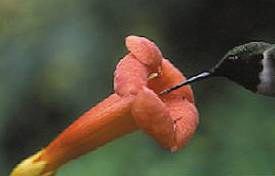 Actually, at 3" the flower tube is a bit long for the hummingbird's 3/4" bill, so it's common to see a hummer plunging so deeply into the bloom that its entire head disappears. Usually the bird hovers while nectaring, but sometimes it gets a toe-grip on the lower flower petal and holds on for several seconds. Actually, at 3" the flower tube is a bit long for the hummingbird's 3/4" bill, so it's common to see a hummer plunging so deeply into the bloom that its entire head disappears. Usually the bird hovers while nectaring, but sometimes it gets a toe-grip on the lower flower petal and holds on for several seconds.
In either case, the hummer's head is positioned perfectly with Trumpet Creeper's stamens and pistil, which lie against the top of the flower tube just inside the lip (top photo and above right). When a hummingbird feeds on Trumpet Creeper nectar, it accumulates pollen deposits that can be dense enough to turn the bird's crown yellow or white,  sometimes fooling a human observer into thinking the bird is color-marked with paint (left). (NOTE: Some banders do use paint to mark hummingbirds for research, but only with a circular dot on the forehead, crown, breast, or back. Ruby-throated Hummingbirds from Hilton Pond Center get a necklace formed by temporary green dye.) Because of the length of its flower tube, Trumpet Creeper nectar is not easily accessible to the proboscis of a moth or butterfly, sometimes fooling a human observer into thinking the bird is color-marked with paint (left). (NOTE: Some banders do use paint to mark hummingbirds for research, but only with a circular dot on the forehead, crown, breast, or back. Ruby-throated Hummingbirds from Hilton Pond Center get a necklace formed by temporary green dye.) Because of the length of its flower tube, Trumpet Creeper nectar is not easily accessible to the proboscis of a moth or butterfly, 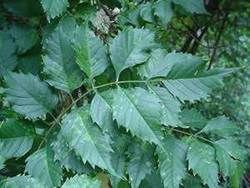 but Bumblebees are able to crawl deep into the flower and--like hummers--facilitate pollination. but Bumblebees are able to crawl deep into the flower and--like hummers--facilitate pollination.
In spring, a Trumpet Creeper vine produces compound leaves with sharply toothed leaflets (right); this dark green foliage makes a perfect backdrop for its brilliant red-orange flowers, which occur on new growth of the year.
Trumpet Creeper is easily started from paper-thin seeds produced abundantly within a long green pod (below left); this pod resembles that of a Southern Catalpa tree (Catalpa bignonioides), so it's no surprise that Trumpet Creeper and catalpas are classified in the same family, the Bignoniaceae. 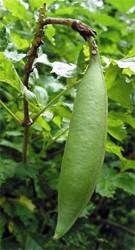 In autumn, pods may be collected and kept in a container outside where they can freeze, after which they will germinate in almost any kind of soil. Small Trumpet Creeper vines can be transplanted with ease. In autumn, pods may be collected and kept in a container outside where they can freeze, after which they will germinate in almost any kind of soil. Small Trumpet Creeper vines can be transplanted with ease.
Here at Hilton Pond Center, Trumpet Creeper blossoms begin to appear in mid-May. Each flower last several days, during which time it produces copious amounts of nectar. The last blooms finish in early September, after which the leaves wither and fall off to reveal a pleasant mid-winter thicket of whitish-tan twigs (below right).
It's certainly no coincidence that the lengthy five-month bloom period of Trumpet Creeper dovetails almost exactly with the span when Ruby-throated Hummingbirds occur in the Carolina Piedmont. Historically, we suspect Trumpet Creeper was around before ruby-throats expanded their range from the tropics into eastern North America--these flowers  probably were a necessary prerequisite for pioneering hummingbirds--and today the nearly omnipresent Trumpet Creeper vine easily may be the ruby-throat's single most important nectar source. probably were a necessary prerequisite for pioneering hummingbirds--and today the nearly omnipresent Trumpet Creeper vine easily may be the ruby-throat's single most important nectar source.
Thus, if all the Trumpet Creepers in the U.S. were to die because of disease or habitat destruction, we suspect it would have a significant--perhaps even devastating--effect on Ruby-throated Hummingbird populations. Conversely, since Trumpet Creeper has other pollinators, it likely would continue to exist without hummers--although perhaps not as prolifically. 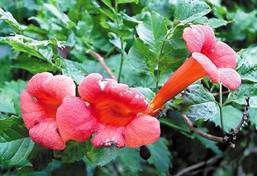 Neither scenario is desirable, of course, which is why we encourage the Trumpet Creeper patch at Hilton Pond Center to grow ever larger each year These persistent vines may eventually take over the old farmhouse and several trees, but at least we'll still have Trumpet Creeper flowers . . . AND our Ruby-throated Hummingbirds. Neither scenario is desirable, of course, which is why we encourage the Trumpet Creeper patch at Hilton Pond Center to grow ever larger each year These persistent vines may eventually take over the old farmhouse and several trees, but at least we'll still have Trumpet Creeper flowers . . . AND our Ruby-throated Hummingbirds.
All photos & text © Hilton Pond Center
If you enjoy "This Week at Hilton Pond," please help Support
Hilton Pond Center for
Piedmont Natural History
|

 "HUMMINGBIRD MORNINGS"
"HUMMINGBIRD MORNINGS"
 (Perhaps a better way to control it is to plant it along a fence and whack it back occasionally if it strays too far.) Using tiny aerial rootlets (left), the vine will climb vertical supports such as power poles and tall trees, eventually spreading its own green foliage in the canopy. In fact, we once saw an ancient Trumpet Creeper vine that was ten inches in diameter-- almost equal in size to the trunk of the tree holding it aloft.
(Perhaps a better way to control it is to plant it along a fence and whack it back occasionally if it strays too far.) Using tiny aerial rootlets (left), the vine will climb vertical supports such as power poles and tall trees, eventually spreading its own green foliage in the canopy. In fact, we once saw an ancient Trumpet Creeper vine that was ten inches in diameter-- almost equal in size to the trunk of the tree holding it aloft. Actually, at 3" the flower tube is a bit long for the hummingbird's 3/4" bill, so it's common to see a hummer plunging so deeply into the bloom that its entire head disappears. Usually the bird hovers while nectaring, but sometimes it gets a toe-grip on the lower flower petal and holds on for several seconds.
Actually, at 3" the flower tube is a bit long for the hummingbird's 3/4" bill, so it's common to see a hummer plunging so deeply into the bloom that its entire head disappears. Usually the bird hovers while nectaring, but sometimes it gets a toe-grip on the lower flower petal and holds on for several seconds. sometimes fooling a human observer into thinking the bird is color-marked with paint (left). (NOTE: Some banders do use paint to mark hummingbirds for research, but only with a circular dot on the forehead, crown, breast, or back. Ruby-throated Hummingbirds from Hilton Pond Center get a necklace formed by temporary green dye.) Because of the length of its flower tube, Trumpet Creeper nectar is not easily accessible to the proboscis of a moth or butterfly,
sometimes fooling a human observer into thinking the bird is color-marked with paint (left). (NOTE: Some banders do use paint to mark hummingbirds for research, but only with a circular dot on the forehead, crown, breast, or back. Ruby-throated Hummingbirds from Hilton Pond Center get a necklace formed by temporary green dye.) Because of the length of its flower tube, Trumpet Creeper nectar is not easily accessible to the proboscis of a moth or butterfly,  but Bumblebees are able to crawl deep into the flower and--like hummers--facilitate pollination.
but Bumblebees are able to crawl deep into the flower and--like hummers--facilitate pollination. In autumn, pods may be collected and kept in a container outside where they can freeze, after which they will germinate in almost any kind of soil. Small Trumpet Creeper vines can be transplanted with ease.
In autumn, pods may be collected and kept in a container outside where they can freeze, after which they will germinate in almost any kind of soil. Small Trumpet Creeper vines can be transplanted with ease. probably were a necessary prerequisite for pioneering hummingbirds--and today the nearly omnipresent Trumpet Creeper vine easily may be the ruby-throat's single most important nectar source.
probably were a necessary prerequisite for pioneering hummingbirds--and today the nearly omnipresent Trumpet Creeper vine easily may be the ruby-throat's single most important nectar source. Neither scenario is desirable, of course, which is why we encourage the Trumpet Creeper patch at Hilton Pond Center to grow ever larger each year These persistent vines may eventually take over the old farmhouse and several trees, but at least we'll still have Trumpet Creeper flowers . . . AND our Ruby-throated Hummingbirds.
Neither scenario is desirable, of course, which is why we encourage the Trumpet Creeper patch at Hilton Pond Center to grow ever larger each year These persistent vines may eventually take over the old farmhouse and several trees, but at least we'll still have Trumpet Creeper flowers . . . AND our Ruby-throated Hummingbirds.